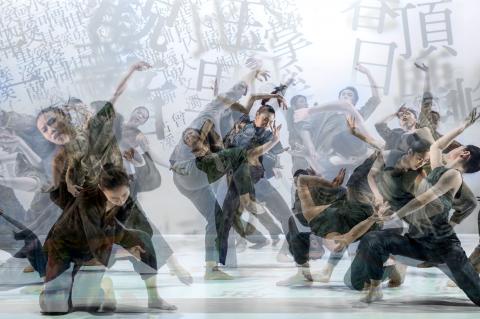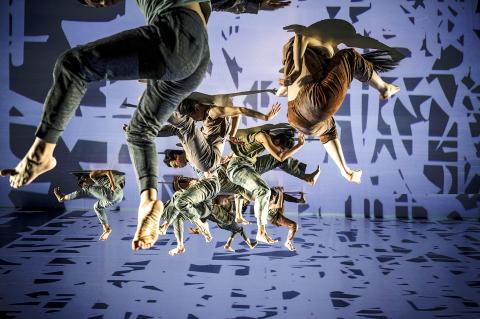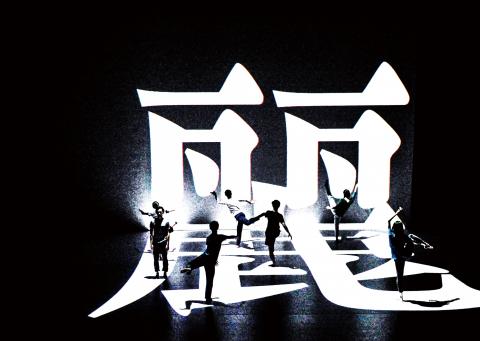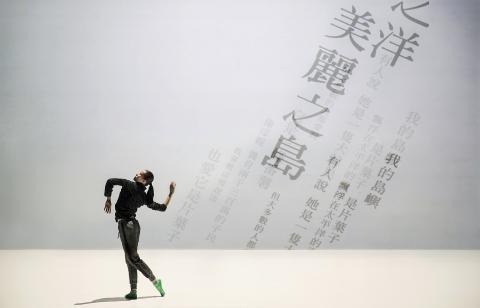Words spill out of Cloud Gate Dance Theatre (雲門舞集) artistic director Lin Hwai-min (林懷民) in torrents of energy, often faster than his dancers’ movements, but just as carefully calibrated. It does not matter if he is speaking Chinese or English, he rushes along, sometimes spinning off on a tangent, but always returning to his core ideas.
Words, especially in their written form, have been as important to Lin as dancing, even from childhood. Long before he founded the nation’s first professional modern dance troupe, he had made his name as a writer, and an author’s storytelling craft has often informed his choreography.
He had his first story published in a newspaper when he was 14, and his 1969 novel Cicada was a best-seller; ancient Chinese tales inspired his early dance works and his Cursive (行草) trilogy was inspired by Chinese calligraphy.

Photo Courtesy of Liu Chen-hsiang
Words, in the shape of Chinese typescript, are the basis upon which he built his newest work, Formosa (關於島嶼): Characters form the backdrop and landscape of his story about the land, history and people of Taiwan, while a recitation — a selection of poems and excerpts of essays about the land and the people — by poet, calligrapher and painter Chiang Hsun (蔣勳) is part of the soundscape.
Thirty-nine years ago with Legacy (渡海), which many experts cite as the watershed production that shaped Taiwan’s contemporary dance scene, Lin told the story of the early Han Chinese settlers who crossed the “Black Water” — the Taiwan Strait — hundreds of years ago in search of a better life than the ones wracked by famine and wars they were leaving behind.
Formosa tells of those settlers, but the main focus is the island’s Aborigines, as well as the foreign soldiers and traders and others who came after them, all combining to form the multi-ethnic, multicultural island we know today. It is also a story of island shaped by tragedy, some man-made in the form of conquests and political ideology, others wrought by Mother Nature through typhoons and earthquakes.

Photo Courtesy of Liu Chen-hsiang
However, Formosa is far more abstract than Legacy, the storytelling not so linear.
In a telephone interview with Lin before he took his company on a six-city tour of China last month, Lin said that with Formosa he was not trying to talk about Taiwan as a news report, editorial or philosophy.
“Formosa is just a metaphor for an island haunted by earthquakes, typhoons and international fights… the material is grown from the land, but it’s not about land, it’s about everywhere,” Lin said.

Photo Courtesy of Liu Chen-hsiang
“There is an epigram from the Diamond Sutra: All things contrived are like dream, illusion, bubble, shadow; and as dewdrop or lighting. They should be regarded as such,” Lin said. “I have had that in the back of my mind all my life.”
The show starts with whiteness and ends with emptiness, he said.
“The first characters are projected as a subtitle for Mr Chiang’s recitation for a few minutes, then they go on their own way,” he said. “First the poem, the characters are seen afterwards,” he added.

Photo Courtesy of Liu Chen-hsiang
Asked why he decided have Chinese characters play such a key role in the new work, given that he had explored Chinese calligraphy in his Cursive trilogy, he said it was because “words communicate … but they become blurred with the passage of time. Records of history could be erased, rewritten.”
Often the characters used in the projections are the names of animals, villages, rivers and places in Taiwan, “but they are mostly broken. Tam (淡) here, shui (水) over there,” he said, referring to a district of New Taipei City. “They are broken, painted for landscape … made abstract pictures to evoke memories of ancient writing.”
“The characters expand... into rivers of words, then become a landscape, they drop like rocks, like bombs on the floor, they become a monster, kill people,” he said using his usual rapid-fire delivery. “We did a wonderful ‘bang, bang, bang, bang onto floor.’”
Then from out of the darkness come stars, each one made of a character, he said.
“They are like glowing diamonds onto the dancers... Some stars are amplified, drift into space,” he said. “A lot of words gradually break. Wo ai ni (“I love you,” 我愛你) starts at center stage, then the heart fades away, love without a heart. It is like seeking wrecks of spaceships floating away.”
The projection design was done by Chou Tung-yen (周東彥) and Very Mainstream Studio, while Howell Chang Hao-jan (張皓然) did the videography.
For the score, Lin used percussive music by Paris-based Finnish composer Kaija Saariaho, Taiwanese musician Liang Chun-mei (粱春美) — who worked with Lin on "Cursive 3" (Wild Cursive, 狂草) — and Puyuma singer Sangpuy Katatepan Mavaliyw.
However, it is Sangpuy as his fans have never heard him; as even the musician had never heard himself. He becomes the voice of nature for the show.
Lin said Sangpuy agreed to work on the production only if several demands were met, including not singing Aboriginal songs or his own works.
“We dragged him, pushed him, finally locked him in the studio where he howled, screamed, murmured,” Lin said. “At end of three [recording] sessions of his voice, our music director patched it together,” he added, but almost deafened himself in the process.
Formosa, which the company has been billing as three years in the making, premieres on Nov. 24 at the National Theater as part of the National Theater Concert Hall’s Dancing in Autumn series, but only because Lin wanted to have the premiere in Taiwan.
The show was originally scheduled to premiere last year at the opening of the Taipei Performing Arts Center in Shilin District (士林), but when construction on the center was stopped temporarily, the company had to come up with Plan B, and that was this month at the National Theater since the show was coproduced with the NTCH.
Other coproducers include the National Kaohsiung Center for the Arts (another project that is years behind schedule), Sadler’s Wells in London, the Theatre de la Ville in Paris and the Carolina Performing Arts at the University of North Carolina at Chapel Hill, meaning that the show has already been booked for tours to the US, the UK and France starting early next year.
Performances are also set for Germany, Portugal, Russia that will keep the company busy touring the show next year and into 2019.
But first there is Taiwan itself and Cloud Gate’s loyal fanbase. After 10 performances at the National Theater, Cloud Gate will take the show to Taichung, Kaohsiung and Lin’s hometown of Chiayi.

This is the year that the demographic crisis will begin to impact people’s lives. This will create pressures on treatment and hiring of foreigners. Regardless of whatever technological breakthroughs happen, the real value will come from digesting and productively applying existing technologies in new and creative ways. INTRODUCING BASIC SERVICES BREAKDOWNS At some point soon, we will begin to witness a breakdown in basic services. Initially, it will be limited and sporadic, but the frequency and newsworthiness of the incidents will only continue to accelerate dramatically in the coming years. Here in central Taiwan, many basic services are severely understaffed, and

It is a soulful folk song, filled with feeling and history: A love-stricken young man tells God about his hopes and dreams of happiness. Generations of Uighurs, the Turkic ethnic minority in China’s Xinjiang region, have played it at parties and weddings. But today, if they download it, play it or share it online, they risk ending up in prison. Besh pede, a popular Uighur folk ballad, is among dozens of Uighur-language songs that have been deemed “problematic” by Xinjiang authorities, according to a recording of a meeting held by police and other local officials in the historic city of Kashgar in

Jan. 5 to Jan. 11 Of the more than 3,000km of sugar railway that once criss-crossed central and southern Taiwan, just 16.1km remain in operation today. By the time Dafydd Fell began photographing the network in earnest in 1994, it was already well past its heyday. The system had been significantly cut back, leaving behind abandoned stations, rusting rolling stock and crumbling facilities. This reduction continued during the five years of his documentation, adding urgency to his task. As passenger services had already ceased by then, Fell had to wait for the sugarcane harvest season each year, which typically ran from

The People’s Republic of China (PRC) was out in force in the Taiwan Strait this week, threatening Taiwan with live-fire exercises, aircraft incursions and tedious claims to ownership. The reaction to the PRC’s blockade and decapitation strike exercises offer numerous lessons, if only we are willing to be taught. Reading the commentary on PRC behavior is like reading Bible interpretation across a range of Christian denominations: the text is recast to mean what the interpreter wants it to mean. Many PRC believers contended that the drills, obviously scheduled in advance, were aimed at the recent arms offer to Taiwan by the